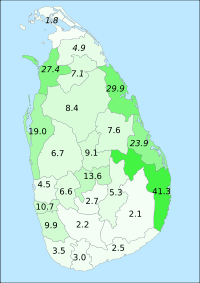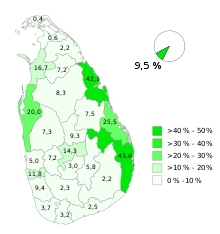Islam in Sri Lanka
Islam is a minority religion in Sri Lanka. 9.7%[1] of the Sri Lankan population practice Islam. 1,967,227 persons adhere to Islam as per the census of 2012.[1] Islam in Sri Lanka existed in communities along the Arab coastal trade routes in Ceylon as soon as the religion originated and had gained early acceptance in the Arabian Peninsula.


History of Islam in Sri Lanka
With the arrival of Arab traders in the 7th century A.D., Islam began to flourish in Sri Lanka. The first people to profess the Islamic faith were Arab merchants and their native wives, whom they married after having them converted to Islam. By the 8th century A.D., Arab traders had taken control of much of the trade on the Indian Ocean, including that of Sri Lanka. Many of them settled down on the island in large numbers, encouraging the spread of Islam. However, when the Portuguese arrived during the 16th century, many of these Arab traders' descendants - now called the Sri Lankan Moors - were the main traders in spice, with networks extending to the Middle East. The Portuguese colonists attacked, persecuted, and destroyed the Sri Lankan Moor settlements, warehouses, and trading networks. Many defeated Moors sought refuge from persecution by escaping to the interior of Sri Lanka. The population of Sri Lankan Moors declined significantly during the Portuguese colonial rule due to the pogroms against the Moors. The Sinhalese ruler King Senarat of Kandy gave refuge to some of the Muslims in the central highlands and Eastern Province, Sri Lanka.[2]
During the 18th and 19th centuries, Javanese and Malaysian Muslims brought over by the Dutch and British rulers contributed to the growing Muslim population in Sri Lanka. Their descendants, now the Sri Lankan Malays, adopted several Sri Lankan Moor Islamic traditions while also contributing their unique cultural Islamic practices to other Muslim groups on the Island.
The arrival of Muslims from India during the 19th and 20th centuries has also contributed to the growth of Islam in Sri Lanka. Most notably, Pakistani and South Indian Muslims have introduced Shafi'i and the Hanafi school of thought into Sri Lanka. Most Muslims on the island adhere to the traditional practices of Sunni Islam.
Muslims generally follow Sufi traditions. The Fassiya ash Shazuliya tariqa, which has its headquarters in Ummu Zavaya in M.J.M. Laffir mawatha, Colombo, supported by the Al-Fassi family in the 1870s, is the most prevalent Sufi order among the Sri Lankan Muslims followed by Aroosiyathul qadiriya. The Deobandi Tablighi Jamaat, jamathe islame and thawheed jamath etc. also have centers in Colombo.[3] Sunni scholar Muhammad Abdul Aleem Siddiqi built Hanafi Masjid in Colombo for Sri Lankan Muslims.[4]
In modern times, Muslims in Sri Lanka are handled by the Muslim Religious and Cultural Affairs Department, which was established in the 1980s to prevent the continual isolation of the Muslim community from the rest of Sri Lanka. Muslims of Sri Lanka, mostly continue to derive from the Moor and Malay ethnic communities on the island with smaller numbers of converts from other ethnicities, such as the Tamils.
In recent years, Sri Lankan Muslims have become more affected by the growing influence of Salafism due to investment from Saudi Arabia, Sri Lankan Sufi Muslims have been wary of increasing Wahhabism among Sri Lankan Muslims.[5] The brutal 2019 Sri Lanka Easter bombings revealed that the radical National Thowheeth Jama'ath, a Salafi influenced organization, was behind the bombings, leading to increasing censorship of the Salafi movement in Sri Lanka.[6]
Population


| Census | Population | Percentage |
|---|---|---|
| 1881 | 197,800 | 7.17% |
| 1891 | 212,000 | 7.05% |
| 1901 | 246,100 | 6.90% |
| 1911 | 283,600 | 6.91% |
| 1921 | 302,500 | 6.72% |
| 1931 Estimate | 354,200 | 6.67% |
| 1946 | 436,600 | 6.56% |
| 1953 | 541,500 | 6.69% |
| 1963 | 724,000 | 6.84% |
| 1971 | 901,785 | 7.11% |
| 1981 | 1,121,717 | 7.56% |
| 2012 | 1,967,523 | 9.66% |
The districts of Ampara (43%), Trincomalee (42%) and Batticaloa (26%) in Eastern Province have the highest share of Muslims in Sri Lanka, followed by Puttalam (20%), Mannar (17%), Kandy (14%) and Colombo (12%).
Sri Lankan Moors

The Sri Lankan Moors are mostly native speakers of the Tamil language while a few of them speak Sinhala as primary language, and follow Islam as their religion. Sri Lankan Moors comprise 9.30% (2012 Census) of Sri Lanka's population, and constitute the largest ethnic group within the Muslim community in the country.[7]
Islam was spread to Sri Lanka by contacts with the merchant ships operated by the Moor traders between Serendib (Old Persian / Arabic name for Sri Lanka), and various ports in the Arabian Peninsula and North Africa. As per scholars, Sri Lankan Moors are descendant of the Marakkar, Mappilas, Memons and Pathans of South India.[8]
Education
There are 749 Muslim schools in Sri Lanka, 205 madrasas which teach Islamic education, and an Islamic university in Beruwala (Jamiya Naleemiya). Al Iman Schools in Colombo was the first organization of Islamic schools of its kind, teaching an integrated Islamic curriculum since 2008. In the early 20th century there were few Muslim professionals in accounting, medicine, engineering, etc., but at present they are exceeding the national average. Due to the lack of opportunity in Sri Lanka, many Muslim professionals are emigrating to get jobs abroad, such as to the Middle East, United States, Canada, Australia, and Europe. The Moors have had better social and economic mobility, thanks to the historic head start they had in getting education and government jobs under the British colonial rule.[9]
East Coast Moors
In the eastern provinces of the country Muslims are predominant. These Muslims were settled on land given by the Sinhalese King Senarat of Kandy after the Muslims were persecuted by the Portuguese.[2] East coast Sri Lankan Moors are primarily farmers, fishermen, and traders. According to the controversial census of 2007, the Moors are 5% (only Moors, not the entire Muslim population of the eastern province). Their family lines are traced through women, as in kinship systems of the southwest Indian state of Kerala, but they govern themselves through Islamic law.[10]
West Coast Moors
Many moors in the west of the island are traders, professionals or civil servants and are mainly concentrated in Colombo, Kalutara, Beruwala, Dharga Town, Puttalam, Jaffna, Kandy, Matale, Vavuniya and Mannar. Moors in the west coast trace their family lines through their father. Along with those in the Central Province, the surname of many Moors in Colombo, Kalutara and Puttalam is their fathers first name, thus retaining similarity to the traditional Arab and middle eastern kinship system.
The Malays

The Malays of Sri Lanka originated in Southeast Asia and today consist of about 50,000 persons. Their ancestors came to the country when both Sri Lanka and Indonesia were colonies of the Dutch. Most of the early Malay immigrants were indentured labours, posted by the Dutch colonial administration to Sri Lanka, who decided to settle on the island. Other immigrants were convicts or members of noble houses from Indonesia who were exiled to Sri Lanka and who never left. The main source of a continuing Malay identity is their common Malay language (Bahasa Melayu), which includes numerous words absorbed from Sinhalese and the Moorish variant of the Tamil language. In the 1980s, the Malays made up about 5% of the Muslim population in Sri Lanka and, like the Moors, predominantly follow the Shafi school of thought within Sunni Islam.
Indian Muslims (Memons, Bohras, Khojas)
The Indian Muslims are those who trace their origins to immigrants searching for business opportunities during the colonial period. Some of these people came to the country as far back as Portuguese times; others arrived during the British period from various parts of India. The majority of them came from Tamil Nadu and Kerala states, and unlike the Sri Lankan Moors, are ethnically related to South Indians and number approximately 30,000. The Memon, originally from Sindh (in modern Pakistan), first arrived in 1870; in the 1980s they numbered only about 15,000, they mostly follow the Hanafi Sunni school of Islam.
The Dawoodi Bohras and the Khoja are Shi'a Muslims who came from western India (Gujarat state) after 1880; in the 1980s they collectively numbered fewer than 2,000. These groups tended to retain their own places of worship and the languages of their ancestral homelands.
Ex-Muslims
Some Sri Lankans who were raised as Muslims, or converted to Islam in later life, have left Islam. Due to the social taboo on apostasy, the Council of Ex-Muslims of Sri Lanka (CEMSL) was founded in secret in 2016. Members of the organisation hold meetings in hiding. In June 2019, Rishvin Ismath decided to come forward as spokesperson for the Council in order to denounce government-approved and distributed textbooks for Muslim students which stated that apostates from Islam should be killed. Ismath subsequently received several death threats.[11]
See also
Notes
- "Census of Population and Housing of Sri Lanka, 2012 – Table A3: Population by district, ethnic group and sex" (PDF). Department of Census & Statistics, Sri Lanka.
- "Archived copy". Archived from the original on 2013-05-24. Retrieved 2012-08-27.CS1 maint: archived copy as title (link)
- Gugler 2011
- "Roving Sufi Ambassadors of Islam".
- "The Wahhabi Invasion of Sri Lanka". 27 March 2013.
- "I24NEWS".
- "Census of Population and Housing 2011". www.statistics.gov.lk. Retrieved 2017-12-17.
- Holt, John (2011-04-13). The Sri Lanka Reader: History, Culture, Politics. Duke University Press. p. 429. ISBN 978-0-8223-4982-2.
- "Analysis: Tamil-Muslim divide". BBC News World Edition. 27 June 2002. Retrieved 6 July 2014.
- "Kmaraikayar". Retrieved 2007-07-02.
- Hella Camargo (17 January 2020). "Sri Lanka: Apostaten in Lebensgefahr". Diesseits (in German). Humanistischer Pressedienst. Retrieved 26 July 2020.
References

- Victor C. de Munck. Experiencing History Small: An analysis of political, economic and social change in a Sri Lankan village. History & Mathematics: Historical Dynamics and Development of Complex Societies. Edited by Peter Turchin, Leonid Grinin, Andrey Korotayev, and Victor C. de Munck, pp. 154–169. Moscow: KomKniga, 2006. ISBN 5-484-01002-0
- Pieris, Kamalika. The Muslims and Sri Lanka..Mission Islam, 2006.
